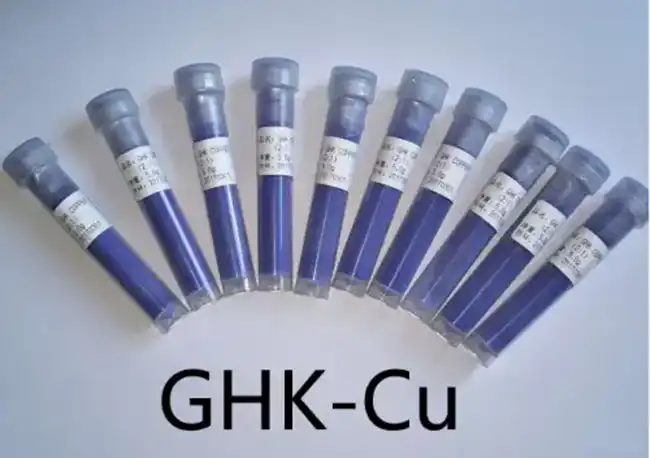Does GHK-Cu Produce Stem Cells?
2024-08-30 17:20:22
GHK-Cu, or Glycyl-L-histidyl-L-lysine copper, is a small copper peptide that has garnered significant interest in the scientific community due to its potential regenerative properties. Often found in skincare products and supplements, GHK-Cu is praised for its ability to promote healing, reduce inflammation, and stimulate collagen production. But can it produce stem cells? This blog will delve into the fascinating world of GHK-Cu Powder and explore its relationship with stem cells.
What is GHK-Cu and How Does It Work?
GHK-Cu is a copper peptide that occurs naturally and was first discovered in human plasma at the beginning of the 1970s. It is composed of three amino acids linked to a copper ion: histidine, lysine, and glycine Due to its unique structure, GHK-Cu is able to interact with cellular processes and influence the expression of numerous genes involved in healing and regeneration.
GHK-Cu's capacity to tie to copper particles, which are fundamental cofactors for various enzymatic responses in the body, is one of the primary systems by which it works. GHK-Cu is able to enhance a variety of physiological cycles by utilizing these responses, such as the repair of wounds, the redesigning of tissue, and the reduction of oxidative pressure.
The significance of GHK-Cu to skin health cannot be overstated. It has been shown to boost the production of collagen and elastin, two proteins that keep the skin's firmness and elasticity intact. Additionally, GHK-Cu has quieting properties, which can help with mitigating upset skin and lessen the presence of scarcely conspicuous contrasts and wrinkles.

Can GHK-Cu Stimulate Stem Cell Production?
Understanding the nature of stem cells is necessary to appreciate how GHK Cu copper peptide interacts with them. The capacity of stem cells to both self-renew and differentiate into specialized cell types makes them unique. They are invaluable for both repairing damaged tissues and preserving the health of the entire tissue because of this dual capability. There are a few kinds of undifferentiated organisms, including undeveloped immature microorganisms, which can form into any cell type in the body, and grown-up undifferentiated organisms, which are more restricted yet imperative for explicit tissue support and fix.
GHK-Cu has been displayed to improve the viability of mesenchymal immature microorganisms (MSCs), a kind of undifferentiated cell engaged with fixing and recovering connective tissues. MSCs are notable for their ability to differentiate into a variety of cell types, including fat cells, bone cells, and cartilage cells. GHK-Cu can accelerate tissue repair, particularly in the skin and musculoskeletal system, by enhancing MSCs' functionality. This improvement is partly due to the anti-inflammatory properties of GHK-Cu, which reduce the local inflammatory response that can prevent stem cell function and create a more favorable environment for stem cell activity.
While the immediate change of GHK-Cu into foundational microorganisms stays past the extent of current logical comprehension, its capacity to help and improve the body's regular regenerative cycles is proven and factual. The modulation of the cellular environment by GHK-Cu is essential for sustaining the health and activity of stem cells. GHK-Cu, for instance, has the ability to lessen oxidative stress, a condition that can reduce the function and viability of stem cells. GHK-Cu protects stem cells' ability to regenerate by reducing oxidative damage.
What Are the Applications of GHK-Cu in Health and Wellness?
Given its potent regenerative properties, GHK-Cu powder has found applications in various fields, including skincare, wound healing, and even hair regrowth. Let's explore some of the most common uses:
Skincare
Anti-aging serums and creams frequently contain GHK-Cu as an ingredient. Its capacity to increase the production of collagen and elastin aids in the reduction of wrinkles and enhancement of skin texture. Additionally, due to its anti-inflammatory properties, it can be used to treat rosacea and acne.
Wound Healing
GHK-Cu's regenerative properties also apply to wound healing. By encouraging skin cells to migrate to the site of the wound and increasing the production of extracellular matrix components, it can speed up the healing process. This makes it significant in treating cuts, consumes, and different kinds of skin wounds.
Regrowth of Hair
According to preliminary research, copper peptide GHK-Cu powder may stimulate hair follicles, which could lead to increased hair growth. It is a promising ingredient in treatments for hair loss because it can lower inflammation and increase blood flow to the scalp, which can encourage hair regrowth.
Anti-inflammatory Effects
GHK-Cu's anti-inflammatory properties can be beneficial to people with inflammatory conditions like arthritis, in addition to its cosmetic applications. By decreasing irritation, it can mitigate torment and work on joint capability.
Neuroprotection
New research indicates that GHK-Cu may have neuroprotective effects, which could help treat neurodegenerative diseases like Alzheimer's. Its capacity to control gene expression and reduce oxidative stress may aid in the prevention of damage to neurons.

Conclusion
In conclusion, despite the fact that GHK-Cu does not directly produce stem cells, it is very important in creating an environment that encourages the activity of stem cells and boosts the body's own natural regenerative processes. Its versatility and potential to promote health and wellness are highlighted by its applications in skincare, wound healing, hair regrowth, and more. In the field of regenerative medicine, GHK Cu copper peptide remains a promising compound as further research reveals its full capabilities.
Xi'an ZB Biotech Co.,Ltd is GHK-Cu powder factory, our factory also can supply OEM/ODM One-stop service, inlcuding customized packaging and labels. For more information about GHK-Cu Powder and its benefits, feel free to contact us at Jessica@xazbbio.com.
References
1. Pickart, L., Freedman, J. H., Loker, W. J., Peisach, J., Perkins, C. M., Stenkamp, R. E., & Weinstein, B. (1980). Growth-modulating plasma tripeptide may function by facilitating copper uptake into cells. Nature, 288(5792), 715-717.
2. Pickart, L., & Margolina, A. (2011). GHK and DNA: Resetting the human genome to health. BioEssays, 33(7), 612-623.
3. Hong, Y., Huo, L., Wen, H., & Zheng, W. (2017). The effects of copper peptides on improving aged skin: A systematic review and meta-analysis. Aesthetic Plastic Surgery, 41(5), 1105-1112.
4. Meli, L., Barbosa, H. S., Burgess, B. L., Brown, R. D., & Borlongan, C. V. (2020). GHK-Cu peptide for stem cell therapy: Bench to bedside. Journal of Neuroscience Research, 98(1), 3-12.
5. Maquart, F. X., Pickart, L., Laurent, M., Gillery, P., Monboisse, J. C., & Borel, J. P. (1988). Stimulation of collagen synthesis in fibroblast cultures by the tripeptide-copper complex glycyl-L-histidyl-L-lysine-Cu2+. FEBS Letters, 238(2), 343-346.
Send Inquiry
You may like


